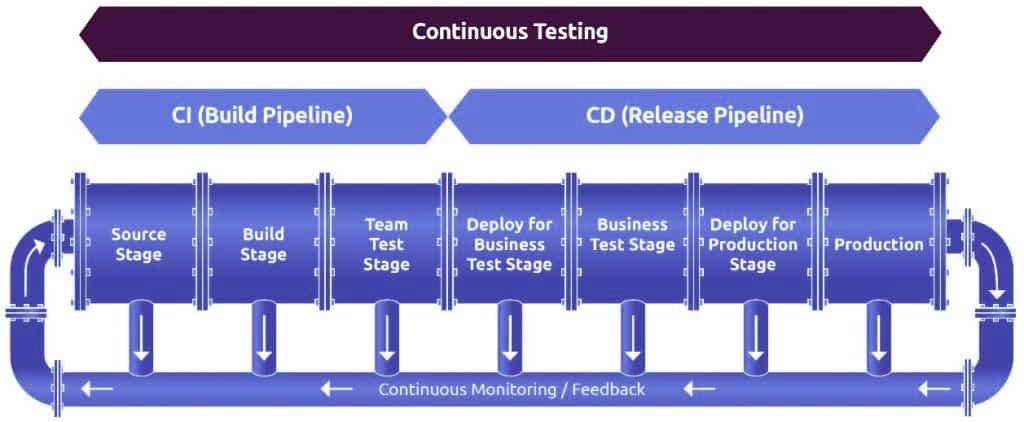How DevOps helps your Company to Grow?
When DevOps arrived onto the technology platform, industry experts opined that it is going to revolutionize the IT world. However, businesses were slow to embrace this methodology. The reason was that many businesses could not understand what DevOps is actually about. As it is not a tool or a technology, people derive their own definitions, processes and methods. DevOps is a methodology that integrates Development and Operations teams to work as a single entity right through the product lifecycle to deliver quality software faster. According to Research Dive, the global DevOps market was valued at $4.46 billion in 2020. This value is expected to reach $23.36 billion by 2027, growing at a CAGR of 22.9% during 2020-2027.
Here is how DevOps helps your company to grow:
Redefining Organizational Culture
While DevOps started off as a combination of development and operations teams, it has now evolved to include everyone involved in the product lifecycle. DevOps brings cross-functional teams into the picture comprising people from design, development, QA, operations, security etc. It facilitates seamless collaboration and trust between teams, breaking silos. With rightly aligned priorities and shared goals, every member of the team gains clear visibility into the progress of the project, resulting in a quality product delivered in time. It gives you better control over tools, processes and projects.
Redefining Technical Processes
Faster time to market is a key requirement to stay in the competition in today’s fast-paced world. However, speed shouldn’t kill the quality. DevOps allows you to deliver faster while not compromising on quality. Continuous Integration / Continuous Delivery (CI/CD) is a notable feature of DevOps.
In a traditional waterfall software development model, developers write the code first which is then sent to the testing team. If there are errors, the code is returned to developers for corrections. When the code successfully passes the test, it is sent to the staging environment and then deployed to production. To deliver an update, the product has to go through the entire process again.
With the advent of Microservices and agile methodologies, developers started developing the software as modular independent services in smaller and incremental cycles. DevOps helps businesses to manage microservices, SOA and agile environments in a better way. It integrates different disparate systems to work as a cohesive unit. It allows you to build a CI/CD pipeline and automate the entire process.

In this CI/CD pipeline, coders write the code and commit it to a version control system that acts as a central repository. When a change is detected, the CI server automatically runs the builds. Passed builds are moved to the deployment segment or the image repository. The automation deployment tool picks the artifacts from there are deploys them to production. There is a continuous monitoring tool that offers feedback from which you can gain clear insights into the performance of the product. By using value stream mapping, you can quickly identify bottlenecks and optimize every process. Response times get quicker too. With continuous integration, continuous testing, continuous deployment and continuous feedback, DevOps enables you to quickly deliver quality software.
Jenkins, Gitlab, CircleCI, TeamCity and Bamboo are some of the best CI tools that help you to automate and orchestrate the entire software development product lifecycle.
Redefining Business Processes
DevOps brings a cultural shift across the organization. Now, developers understand the challenges faced by the Ops guys and develop the code accordingly. Similarly, operations guys are aware of how the code is being developed and how it performs in production at an early stage. As each member is responsible for the overall quality of the product, every team equally cares for the efficient execution of tasks of other teams. They motivate and encourage other members wherever possible. With a cross-functional team working together, employees are cross-trained and up-skilled as well. It not only brings more value to the organization but also delivers more value to your customers.
Innovation is a key requirement to stay ahead of the competition. DevOps gives developers extra time to experiment and create new products or tweak existing products. With automated testing and automated security built into the pipeline, you don’t have to worry about breaking anything. Without disrupting the project, developers can validate the feasibility of ideas and introduce innovation into business processes. It also helps them learn customer requirements and user experiences in a better way and meet/exceed their expectations. Enhanced customer satisfaction helps you retain your customers and gain new referrals too.
The Bottom Line
DevOps benefits are equally distributed across the business, technical or cultural segments of an organization. A good DevOps strategy helps an organization sustainably grow in all aspects of the business. However, streamlining an end-to-end delivery pipeline is a challenge. Once the right DevOps strategy is designed, you can fully leverage all these benefits.
The key here is choosing the right DevOps partner!
Cloud Development – All You Need to Know
In today’s cloud era, every IT resource is hosted in the cloud and delivered over the Internet via a pay-per-use subscription model. While the amazing benefits offered by the cloud have inspired the software industry to embrace cloud development, the recent pandemic has forced everyone to move towards the digital world. As work-from-home environments are here to stay, cloud development has now become more important than ever.
What is Cloud Development?
 Cloud development is about developing software applications using computing infrastructure that is hosted in the cloud. Instead of building and managing your servers and physical hardware, you can access technology services hosted in the cloud via a pay-per-use model.
Cloud development is about developing software applications using computing infrastructure that is hosted in the cloud. Instead of building and managing your servers and physical hardware, you can access technology services hosted in the cloud via a pay-per-use model.
Right from servers, data storage and network resources to OS, Middleware and Run-time environment, everything can be accessed over the Internet.
In addition, you gain access to ready-made cloud solutions for monitoring, analytics etc. Amazon is a leading provider of public cloud solutions while VMware tops the private cloud services segment.
Cloud-based apps are highly scalable and flexible. They can be accessed from any device, any location using APIs. The app data is stored in the cloud and resides on the user’s device as a cache enabling the user to work offline. When the app is connected online, the cache data gets updated. Google Docs, Evernote, Canva, Dropbox are a few popular examples of cloud-based apps.
Why is Cloud Development Popular?
Cloud development offers amazing benefits to organizations. Firstly, it eliminates the need to invest heavily in on-premise infrastructure and licensing costs. With a pay-per-use model, you can only pay for the services used. It gives you access to cutting-edge technologies at cost-effective prices. Secondly, cloud development facilitates seamless collaboration between teams located in different geo-locations. Thirdly, cloud development offers high scalability, flexibility, unlimited storage, faster time to market and automatic recovery options. In addition, it automatically updates the software and performs maintenance which means you can focus on building quality software products.
Amazon Web Services (AWS), Microsoft Azure, Google Cloud Platform are the leading providers of cloud development solutions.
Web Apps are not Cloud Apps
Often, cloud development is confused with web development. It is important to understand that all cloud apps are web apps but all web apps are not cloud apps. To be precise, cloud-based apps are an advanced version of web-based apps. Web-based apps depend on browsers and scalability and customization is limited. The data is stored on a single data server. You can’t work offline with web-based apps. On the other hand, cloud apps are highly scalable and customizable. The data is stored across multiple data-centers using replication techniques and you can work offline as well.
Cloud Development Challenges
While cloud development seems a great option, it comes with certain challenges. Cloud development demands seamless collaboration between different teams such as developers, designers, QA managers, data analysts, DevOps engineers etc. The project involves different cloud technologies such as AWS, Azure, GCP etc. So, people working on cloud apps should have good knowledge about various platforms and be able to integrate apps with different services using APIs.
Secondly, cloud development brings security concerns. As such, security should be implemented right into the CI/CD pipeline so that it can become a part of automation. It is recommended to separate app data from app architecture code. Thirdly, cloud development offers higher scalability. However, scalability that is not optimized will overrun your cloud budgets. As such, it is important to have clear network visibility to gain better control over cloud infrastructure.
Conclusion
Mobility solutions, disaster recovery, Flexibility and reduced workloads are some of the key drivers to cloud adoption. However, cloud development requires expert knowledge of cloud technologies. When rightly implemented, cloud development improves your operational efficiencies and optimizes costs while improving user experience.




